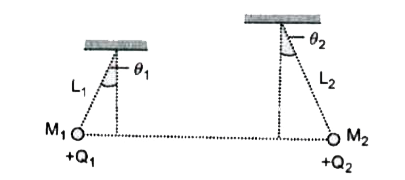A monochromatic light source of frequency villuminates a metallic surface and ejects photoelectron. The electron with maximum energy are just able to ionize the hydrogen atom in the ground state. When the whole experiment is repeated with an incident radiation of frequency 5/6 v, the photoelectrons so emitted are able to excite the hydrogen atom beam which then emits a radiation of the wavelength . Find the work function of the metal : Solution in Kannada
6.875 eV
8.756 eV
7.568 eV
5.687 eV
The correct Answer is:A
In first case
Ionization energy
Now, ionisation potential =13.6V
In second case
Dividing (1) by (2),
or
Topper's Solved these Questions
- ELECTRONS & PHOTONSBOOK - MODERN PUBLICATIONCHAPTER - ELECTRONS & PHOTONSEXERCISE - MULTIPLE CHOICE QUESTIONS (LEVEL-III)
9 Videos
- ELECTRONS & PHOTONSBOOK - MODERN PUBLICATIONCHAPTER - ELECTRONS & PHOTONSEXERCISE - RECENT COMPETITIVE QUESTIONS
20 Videos
- ELECTRONS & PHOTONSBOOK - MODERN PUBLICATIONCHAPTER - ELECTRONS & PHOTONSEXERCISE - RECENT COMPETITIVE QUESTIONS
20 Videos
- ELECTROMAGNETIC WAVESBOOK - MODERN PUBLICATIONCHAPTER - ELECTROMAGNETIC WAVESEXERCISE - RECENT COMPETITIVE QUESTIONS
4 Videos
- ELECTROSTATICSBOOK - MODERN PUBLICATIONCHAPTER - ELECTROSTATICSEXERCISE - RECENT COMPETITIVE QUESTIONS
39 Videos
Similar Questions
Energy required for the electron excitation in Li++ from the first to the third Bohr orbit is :
View SolutionAccording to Einstein's photoelectric equation the graph of K.E. of the photoelectron emitted from the metal versus the frequency of the incident radiation gives a straight line graph whose slope
View SolutionAccording to Einstein's photoelectric equation the graph of K.E. of the photoelectron emitted from the metal versus the frequency of the incident radiation gives a straight line graph whose slope
View SolutionThe speed of electromagnetic wave in vacuum depends upon the source of radiation
View SolutionTwo small spheres of masses M1andM2 are suspended by weightless insulating threads of lengths L1andL2 The spheres carry charges Q1andq2 respectively . The spheres are suspended such that they are in level with one another and the threads are inclined to the vertical at angles of θ1andθ2 as shown . Which one o fthe following conditions , if θ1=θ2 ?

View SolutionA monochromatic light soure of frequency f illuminates a metallic surface and ejects photoelectrons. The photoelectrons having maximum energy are just able to ionize the hydrogen atoms in ground state. When the whole experiment is repeated with an incident radiation of frequency (5)/(6) f , the photoelectrons so emitted are able to excite the hydrogen atom beam which then emits a radiation of wavelength 1215 Å . (a) What is the frequency of radiation? (b) Find the work- function of the metal.
View SolutionThe ionization enegry of the electron in the hydrogen atom in its ground state is 13.6 ev . The atoms are excited to higher energy levels to emit radiations of 6 wavelengths. Maximum wavelength of emitted radiation corresponds to the transition between
View SolutionThe radiation , emitted due to transition of hydrogen atom from the second excited state to ground state, is incident of the surface of sodium metal. The maximum kinetic energy of the emitted photoelectrons is 10.27 eV. What is the work function of sodium? Given, ionisation energy of hydrogen =13.59 eV.
View SolutionAmong the photoelectrons, emitted due to incidence of light of frequency f on a metal surface , only the electrons having the highest kinetic energy can ionise a hydrogen atom. If this experment is performed with light of frequency 56f , the photoelectron having the highest kinetic energy can excite a hydrogen atom and from this excited hydrogen atom a photon of wavelength 1215 Å is emitted . Determine the (i) work function of the metal and
View SolutionThe ionization energy of the electron in the hydrogen atom in its ground state is 13.6 eV. The atoms are excited to higher energy levels to emit radiations of 6 wavelengths. Maximum wavelength of emitted radiation corresponds to the transition between
View SolutionThe photoelectric threshold frequency of a metal is v. When light of frequency 4v is incident on the metal . The maximum kinetic energy of the emitted photoelectrons is
View SolutionWhen ultraviolet radiation is incident on a surface , no photoelectrons are emitted If a second beam causes photoelectrons to be ejected, it may consist of
View SolutionA monochromatic light of frequency is incident on a metal surface and ejects photoelectrons. The photoelectrons having maximum kinetic energy are just able to ionise a hypothetical atom in ground state. The energy levels of hypothetical one-electron atom' are given by E_(n)=-(29)/(n^(2)) eV , where n = 1,2,3.....When whole experiment is repeated with an incident light of frequency v//2 , the photoelectrons with maximum kinetic energy are just able to ionise hydrogen atom in ground state. Calculate the work function of the metal
View Solutionv आवृत्ति का एकवर्णी प्रकाश स्त्रोत, एक धात्विक पृष्ठ को प्रदीप्त करता है और फोटो-इलेक्ट्रॉन उत्सर्जित करता है। न्यूनतम ऊर्जा वाले फोटो-इलेक्ट्रॉन, निम्नतम स्थिति में हाइड्रोजन परमाणुओं को आयनित मात्र कर सकते है। जब पूरा प्रयोग, (5/6) v आवृत्ति वाली आपतित विकिरण के साथ दोबारा किया जाए, तो उत्सर्जित फोटो-इलेक्ट्रॉन, हाइड्रोजन परमाणु बीम को उत्तेजित कर सकने में समर्थ है जो 1215Å तरंगदैर्ध्य का विकिरण उत्सर्जित करती है। धातु का कार्य-फलन और आवृत्ति v निकाले।
View Solutionहाइड्रोजन परमाणु की आद्य अवस्था में इलेक्ट्रॉन की आयनन ऊर्जा 13.6eV होती है | 6 तरंगदैर्ध्य की तरंगों की विकिरणों के उत्सर्जन के लिये परमाणुओं को ऊपरी ऊर्जा स्तरों तक उत्तेजित किया जाता है | उत्सर्जित विकिरण का अधिकतम तरंगदैर्ध्य इनमें से किस स्थिति परिवर्तन से संबंधित होगा
View Solution
